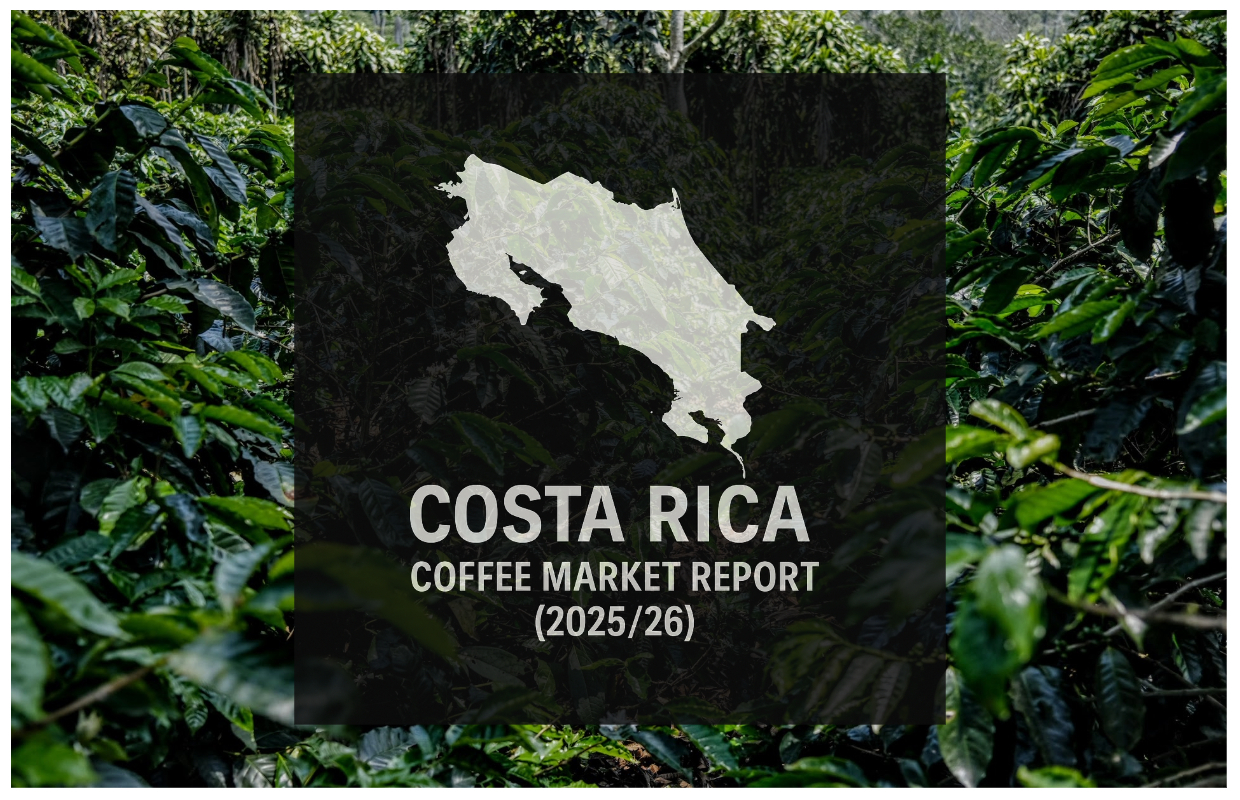Costa Rica’s coffee production is forecast to decline by 10% in the 2025/26 market year, reaching the equivalent of 1.17 million 60-kilogram bags, according to the latest USDA estimates.
The drop reflects the effects of the biennial coffee cycle, as well as ongoing challenges from labor shortages, changing weather patterns and the rising value of the Costa Rican colón.
Coffee exports are expected to fall to 1.06 million bags, down from 1.15 million the previous year. Although global prices have risen, the traditionally strong premium paid for Costa Rican coffee has narrowed, and buyers are cautious amid trade uncertainty.
The number of Costa Rican coffee producers continues to fall, with fewer than 26,000 registered growers in 2023/24 — a 46% drop from a decade ago. Smaller producers now dominate the landscape, while micro-mills and value-added exports play an increasingly important role.
These and other predictions are outlined in the latest USDA Foreign Agriculture Service annual report on the Costa Rica coffee sector.
[Note: This is part of a series of DCN stories that will explore USDA FAS annual coffee reports. The information agency typically delivers more than a dozen country-level reports on the coffee sector, each coming from different authors and field offices.]
📉 Export Outlook
-
Total exports for 2025/26 are projected at 1.06 million 60-kilogram bags, compared to 1.15 million in 2024/25.
-
The U.S. remains the top single-country destination, though its share of total exports declined to 38% in 2023/24, while the EU rose to 41.5%.
-
Top 2023/24 buyers include:
-
United States: 386,307 bags
-
Belgium: 282,162 bags
-
Germany: 60,347 bags
-
South Korea, Japan and Italy follow, in that order
-
-
According to the Costa Rican Coffee Institute (ICAFE), export prices rose 52% year-over-year, reaching an average of $465.65 per bag through April 2025.
-
Despite high prices, premiums for Costa Rican coffee have narrowed, with reduced margin over base market rates.
-
Costa Rica exports almost exclusively green, unroasted coffee, prized for its traceability and sustainability standards.
🌱 Production and Growing Conditions
-
Total production for 2025/26 is forecast at 1.17 million bags, down from 1.3 million in 2024/25 due to the biennial yield decline and other challenges.
-
The Los Santos region (including Tarrazú) remains the highest-producing area, followed by Pérez Zeledón.
-
Late rains and persistent humidity in late 2024 caused fruit loss in many regions.
-
Political conditions in Nicaragua have dramatically reduced the flow of migrant coffee pickers into Costa Rica from the north, causing widespread labor shortages during harvest. Members of the Ngäbe-Buglé tribes in Panama are increasingly being hired as migrant workers.
-
Climate conditions remain volatile, with recent years seeing increased rainfall and higher temperatures, leading to greater disease incidence.
-
Most of Costa Rica’s 83,000 hectares of planted coffee are in highland areas, but 2022 data from ICAFE shows an 11.9% decline in planted area in recent years.
☕ Domestic Consumption
-
Domestic consumption is projected to hold steady at approximately 305,000 bags in 2025/26, as high consumer prices and low population growth constrain demand.
-
Local coffee sales fell 25% year-over-year in 2023/24, dropping to 156,807 bags as inflation and international pricing kept retail prices elevated.
-
Imported coffee makes up a large share of the local market, particularly lower-cost beans from Honduras and Nicaragua.
-
Costa Rica has 46 registered roasters and 102 exporters, with micromills and small-batch production becoming more common in recent years.
🏷️ Imports and Stocks
-
Total imports are forecast at 150,000 bags in 2025/26, including 120,000 green, 25,000 roasted and 5,000 soluble.
-
Imports fluctuate based on price and availability, but have grown over time, especially in the roasted segment (now 18% of total imports).
-
Ending stocks are projected at 105,000 bags, down from 150,000 in 2024/25, as lower production limits surplus.
🏛️ Policy and Sustainability Efforts
-
ICAFE is leading efforts to comply with the EU’s deforestation-free verification (EUDR) rules.
-
In March 2024, Costa Rica completed its first certified deforestation-free export shipment to Italy, involving coffees from 69 producers.
-
Most growers are not yet positioned to meet full EUDR requirement, given technical and logistical barriers, according to the analysis.
-
Training is ongoing to digitize farm data using ICAFE’s CR_CAFE tools, especially for farms over four hectares.
For complete data tables and trend charts, see the full USDA Coffee Annual Report for Costa Rica (May 2025).
Comments? Questions? News to share? Contact DCN’s editors here. For all the latest coffee industry news, subscribe to the DCN newsletter.







Comment